Tamarind and its cultivation

Tamarind (tamarindus) is an exotic fruit native to eastern Africa... Currently, the plant grows in many tropical countries. The tree is found in Sudan, Madagascar and the Arabian Peninsula. In Asia, tamarind grows in India and China, as well as on oceanic islands. Its widespread distribution was facilitated by its cultivation in the open field.
Tamarind is a member of the legume family. In the wild, it can grow up to 25 meters. But in indoor conditions, this is usually a compact tree no higher than 1 meter.
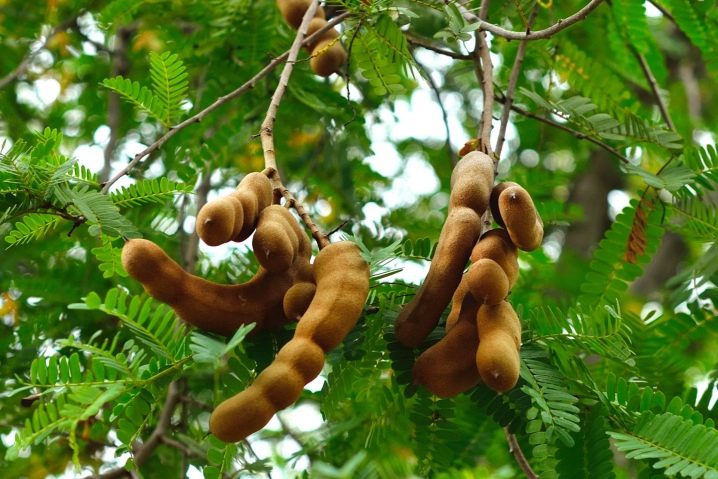
Description
Tamarind is popularly known as Indian date. During the development of navigation, its seeds ended up on the American continent. There the tree successfully took root in the tropics. Outwardly, the tamarind fruit really looks like an ordinary date. And the feathery leaves are similar to acacia leaves. This plant is related to tamarind.
The growth of a tree in a natural environment can reach 30 meters. At the same time, it grows rather slowly. The climate of the tropics contributes to the fact that the crown of the tamarind is always green and lush. Flowers in inflorescences are usually white-pink or reddish.
Fruits are formed in the form of angular-rounded pods with a large number of seeds. The beans grow up to 20 cm in length. Moreover, their thickness reaches only 3 cm. After drying, the pods are compacted. Under the crisp skin is the so-called pericarp. Simply put, it is a pleasant brownish flesh.
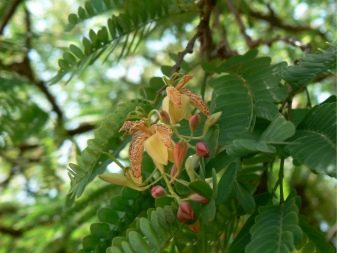

Tamarind is an unusual plant... For example, its beans are not edible, but are used in Asian dishes. The pulp is used in cooking. Pericarp imparts a sweet-sour flavor to seasonings and sauces.
In Asian markets, tamarind is offered in various forms. You can buy salted and dried sweet pulp. And also frozen pieces of the pericarp.
Tropical wood is very durable and dense. It is often compared to mahogany.
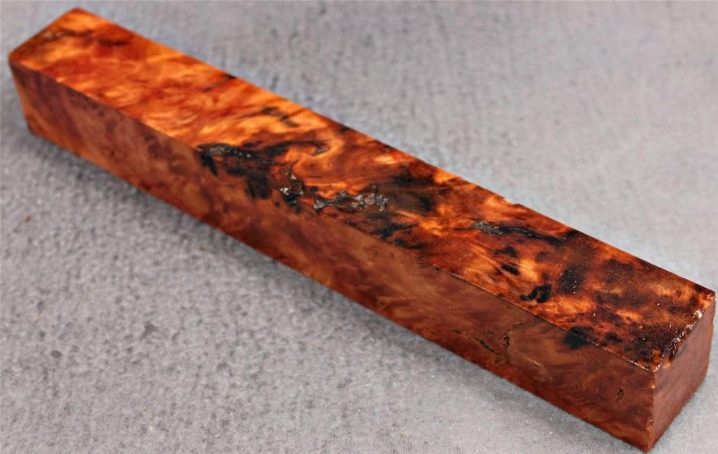
Landing
Tamarind is a popular houseplant. At home, it is most convenient to grow it from purchased seeds. The planting material has an irregular shape and rich chocolate color.
Soak the seeds in warm water before planting. After a couple of hours, they are taken out and dried. The shell on them is very dense and durable. Therefore, to accelerate its growth, it must be scarified. In other words, cut the shell.
It is most convenient to use sandpaper. This procedure promotes the early emergence of overgrowth.
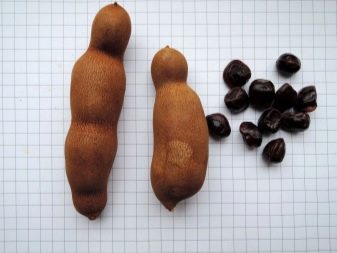

Even inexperienced farmers will be able to plant seeds. To plant seeds, you need to prepare a mixture of peat with perlite. Top crops are sprinkled with a thin layer (5 mm) of purified river sand. After that, they are left in a warm, bright place, away from direct sunlight. The first shoots can be expected 20 days later. At the same time, one should not forget about systematic watering of crops. It is periodically necessary to moisten the soil. Drying out is unacceptable.
Picking into individual pots is carried out after the formation of full-fledged feathery foliage.

Care
Tamarind can be successfully grown at home. Slow-growing perennial, undemanding to care and growing environment. At the same time, the flowering of a plant planted at home in a pot can not wait. Indoor Indian date blooms in rare cases.
Indoor tamarind is small and compact.Often used to form bonsai. Growing and caring for a tree is quite simple. We'll have to observe a certain temperature regime. It differs depending on the season and seasonality.
It is also important to maintain optimum air humidity. The tree is more comfortable to exist in a climate similar to a tropical one. Every day, foliage is required to be sprayed with a spray bottle.

The place should be lit by the sun, it is best to use sills on the south windows.
The substrate requires regular moisture. Overdrying of an earthen coma is not allowed. The soil itself is chosen fertile. A little sand is necessarily mixed into it.
And you will also need to cut, transplant and, as necessary, propagate the plant. These are simple processes. They can be learned quickly if you read the relevant information.
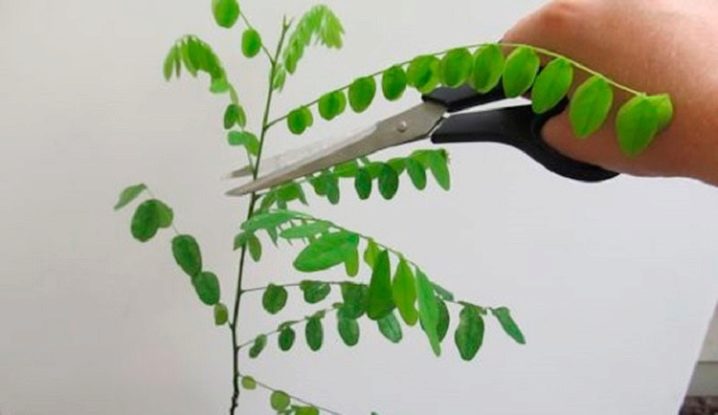
Conditions
-
Bloom... A flowering houseplant of this species is very rare. As a rule, the flowering of the tree falls at the beginning of December. Inflorescences are formed in the form of a brush, consisting of pink or yellowish flowers.
-
Temperature... In the spring and summer, the tree responds favorably to temperatures within + 23 ... 25 degrees. However, an increase in temperature will not harm the plant, because it comes from the sultry tropics. In winter, indoor tamarind should be kept cool and protected from drafts.
-
Air humidity. The tree needs well-humidified air. In the warm season, it should be moistened by spraying in the mornings and evenings. To maintain an optimal level of air humidity near the bush, you can keep an open container with cool water.
-
Capacity and soil mixture... Ceramic flower pots are suitable for growing tamarind. But you can also use plastic containers of a suitable size. The only prerequisite is the presence of drainage holes at the bottom.
-
Dormant period... This "tropical descendant" has no rest period. In winter, an exotic tree is placed in a cool place so that it does not stretch too much.
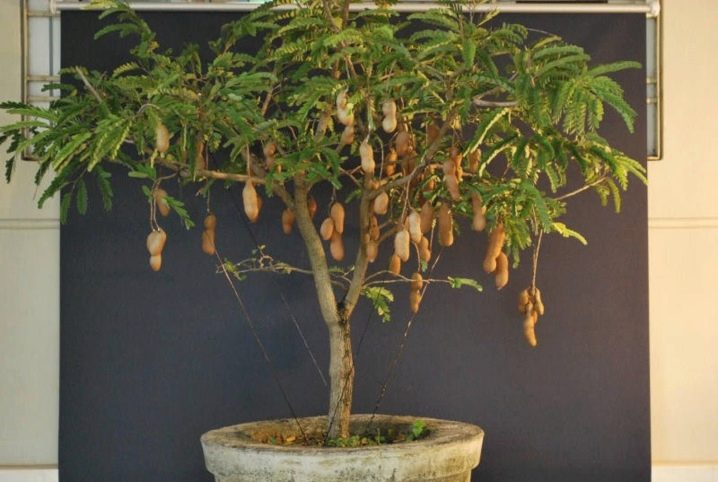
Watering and feeding
Water the tamarind so that the substrate remains moist at all times. But not wet, but moisturized... For irrigation, soft, settled and cold water is suitable. Otherwise, there is a possibility of root decay. In winter, the frequency of watering is reduced. But it is important to keep the soil moist.
Organic fertilizers are ideal for a tropical plant. They should be applied to the soil once a week and only during the warm season. Optimally - from May to September.
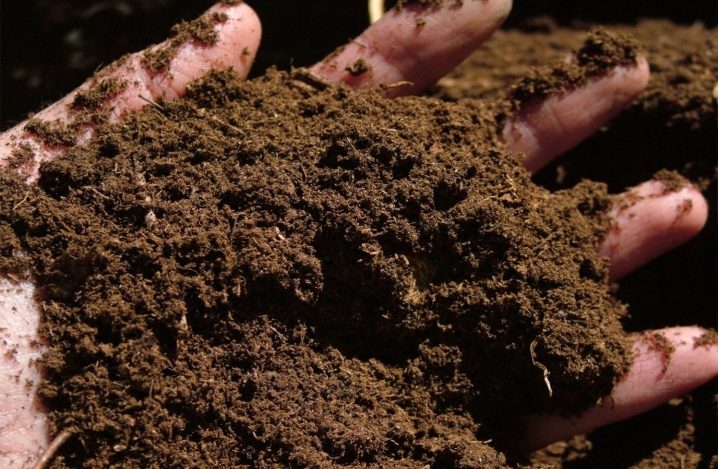
Transfer
When the first young leaves appear on the tree, it can be transplanted to a permanent place. To do this, you need to prepare a new land. Tamarind responds well to loose, breathable soil with a neutral pH of 5.5 to 6.5. You can purchase a universal mixture, or mix the necessary components yourself.
Expanded clay is laid out in the prepared pot, and then the substrate is poured. The sprout with an earthen clod is transferred to a prepared container. From above, you need to cover it with a jar, a cut plastic bottle, or a transparent bag.
The soil is regularly sprayed with water using a spray bottle so as not to damage the fragile plant. When fresh leaves appear, the plant must be accustomed to the indoor climate.
To do this, arrange regular ventilation, opening for a short time. When a few new leaves are added to the sprout, it's time to remove the coating.
Young plants need a transplant every year, and adults no more than once every 3 years. Under ideal conditions, a young tamarind can bloom 6 years after planting.

Crown formation
To give tamarind a more decorative look, it is necessary to shape the crown. For this, pruning and manipulation such as pinching is carried out. After that, the dormant buds wake up, and the crown grows more spreading and thickened.
The first pruning is carried out when the tamarind reaches a height of 60 cm, approximately six months after sowing. Only a healthy tree can be formed. The crown can be arranged in a natural way or palm-like.
The natural appearance assumes a straight trunk and many branches. To enhance branching, pinch the top.
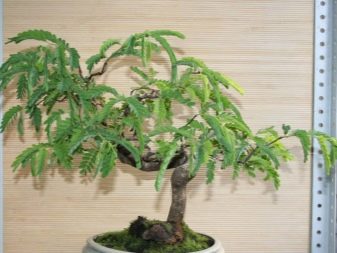
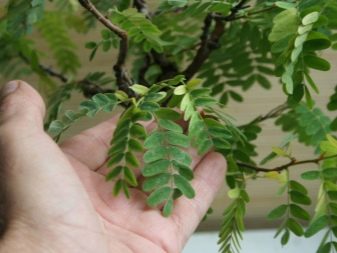
If you want a more compact tamarind, the trunk should be cut at a height of 40 cm from the soil surface. After trimming, a bare trunk is often left. This does not threaten tamarind. If the plant is healthy, branches and foliage will appear within a month.
With regular pruning, keeping the 5 upper branches and pinching the top, it is possible to form a crown in the form of a palm tree.
The trunk can be shaped in different ways.
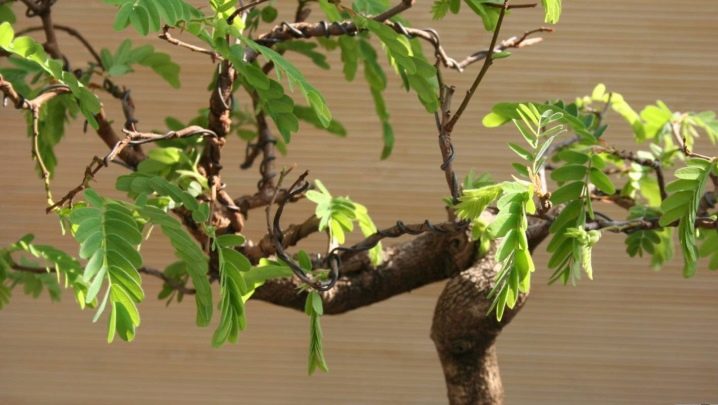
Braiding
The braids are formed from young tamarind trunks. It will take 3-6 plants in one pot. The trunks woven together are fixed with wire or something else. Next, you have to remove unnecessary branches from the trunks in time and pinch the crown for active branching.
The height of the tree is determined according to your own preferences. If you need to get a short plant, you need to pinch the top. Without this, the tamarind will stretch upward. In the process of development, it is necessary to create the next turns of the formed braid.
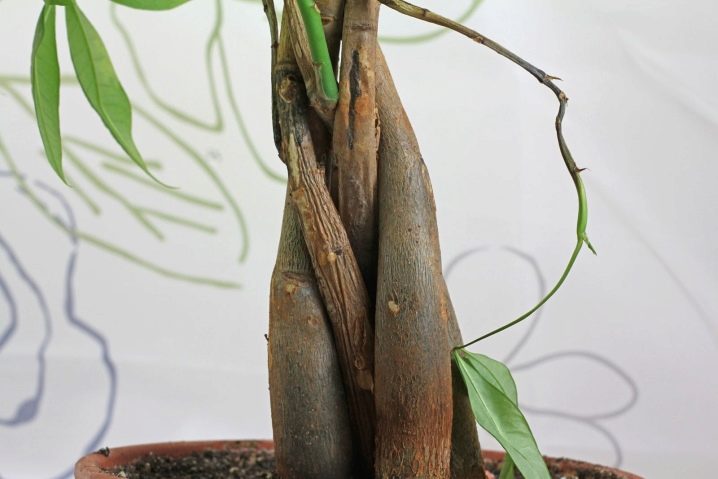
Twisting
In this way, strong, embossed trunks are formed. They are carefully twisted, fastened with wire at each turn. You can bend the tree down, attaching it to the pot itself, or use a special design. In this case, it will be possible to form a curved trunk, similar to those observed in trees in mountainous areas. During the formation period, all unnecessary branches on the trunk are removed.

Flexion
Allows you to grow a tree original in shape. Which one exactly depends on individual preferences. The plant is wrapped with wire, winding it around the trunk, tilting it in those areas where the bend is intended.
In the process, you need to try not to leave depressed marks. If necessary, rubber or other materials can be used under the rigid wire.
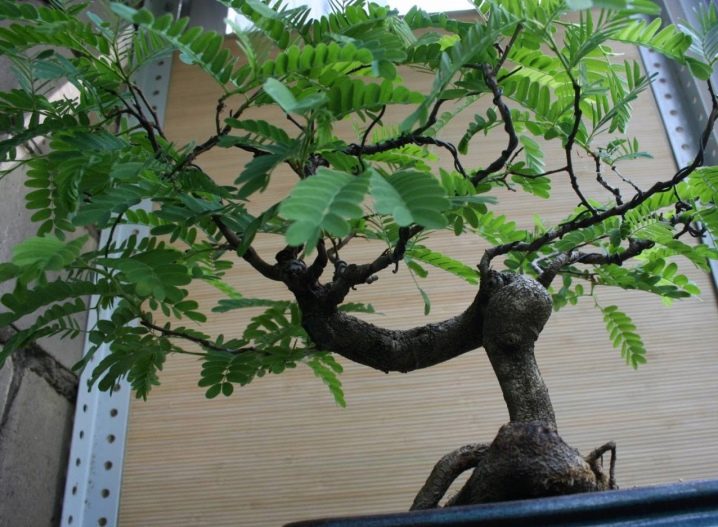
Bonsai
Not every amateur grower dares to grow bonsai, thinking that this is too problematic. In reality, growing bonsai is no more cumbersome than caring for common plant forms.
The main difficulty lies in maintaining the most suitable conditions for its development. For example, tropical plants cannot survive without moist air. Tamarind is unpretentious and develops well in indoor conditions. Even a novice florist will be able to grow such a bonsai.
Routine care is needed in the beginning. The only difference in the composition of fertilizers is nitrogen in them should contain half as much... Bonsai-labeled complex nutritional formulas are suitable. It is also allowed to use 1⁄2 of the dosage recommended for standard fertilizers.
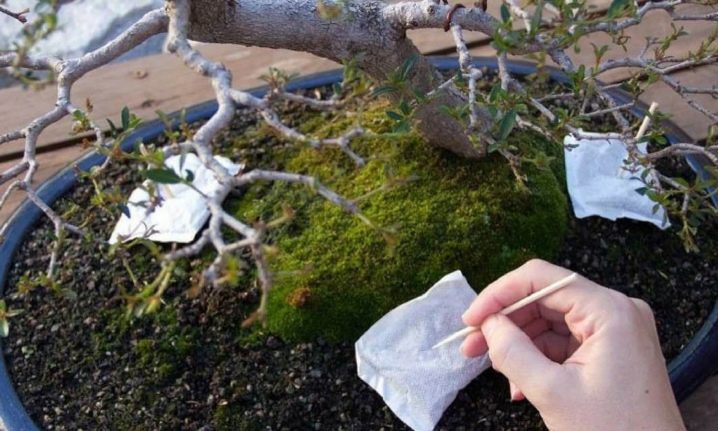
When the plant reaches 6-8 months and 50-60 cm, it is necessary to cut off the top, leaving 35-40 cm. The formation of the trunk begins with bending, twisting and other things. The roots are not touched, and the care is carried out as standard.
At the age of about a year, around April-May, foliage removal (defoliation) is carried out. After it, the leaves become much smaller, but the shape and color are preserved. If the roots are heavily entwined with an earthen lump, you need to choose a larger pot for the plant. Optimally - a liter more.
When the plant reaches two years of age, the first pruning of the roots is carried out.... They are carefully straightened, cutting off all damaged areas by 1/3, processing the sections.
Planting is carried out only in new soil. Shallow but rather wide pots are suitable for bonsai. The roots are carefully straightened on the surface, sprinkled with a layer of substrate, slightly crushed. Can be mulched over the ground with stone chips.
The next year, they are transshipped into a larger pot. The root system is no longer disturbed.The cycle is repeated every 2 years.
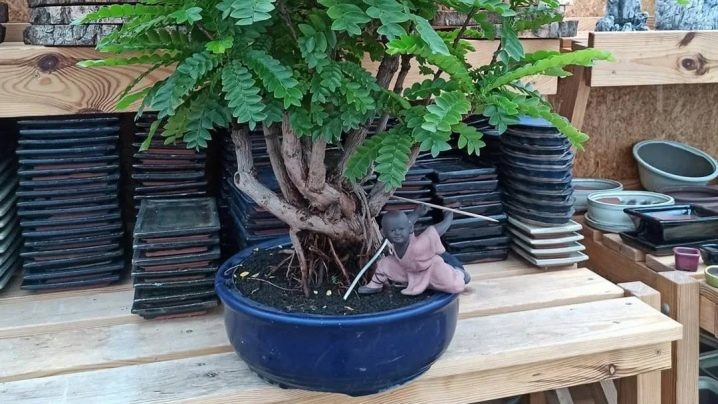
Reproduction
It is easy to grow a tree from a stone. The seeds are distinguished by good germination rates (up to 95%), even if stored for 1-2 years. One fruit contains 4-5 seeds. It is best to plant several seeds at the same time to increase the chance of germination.
In addition to the seed method, vegetative propagation of the tree is used. Absolutely healthy cuttings 10-15 cm long are suitable for germination. Leaves are cut off from the bottom, leaving only a couple of leaves on the top of the cuttings. For each stalk, you need to prepare a container of about 0.3 liters. A slightly acidic nutrient substrate is mixed with sand 2: 1.
The plants are buried 4 cm in the ground. Then they are sprayed and placed under a transparent bag. It takes a month to germinate. During this period, the plant needs to provide the required level of moisture.
If the soil surface becomes moldy, the cover must be removed so that the top layer dries out. You can spray the affected soil with a weak soda solution (0.5 tsp for 1 glass of warm water).
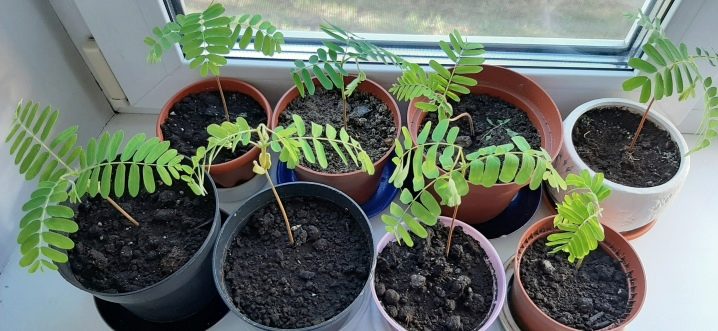
Diseases and pests
Basically, tamarind gets sick with violations of containment measures and improper care. This is how culture can suffer.
-
Leaves and twigs wilted... A sign that the plant does not have enough light and heat.
-
In summer, food shortages are likely. Therefore, it is important to keep the plant in a sunny, warm place. And fertilize more often, but not overdo it.
-
Drops the leaves. The likely cause is low humidity and insufficient watering. The problem is solved by increasing the frequency of spraying.
-
The tree does not grow. This is due to the waterlogging of the soil, rotting of the roots during stagnant water. Watering needs to be adjusted and drainage taken care of. The tamarind is transplanted into new soil as needed. A preliminary examination of the roots is carried out.
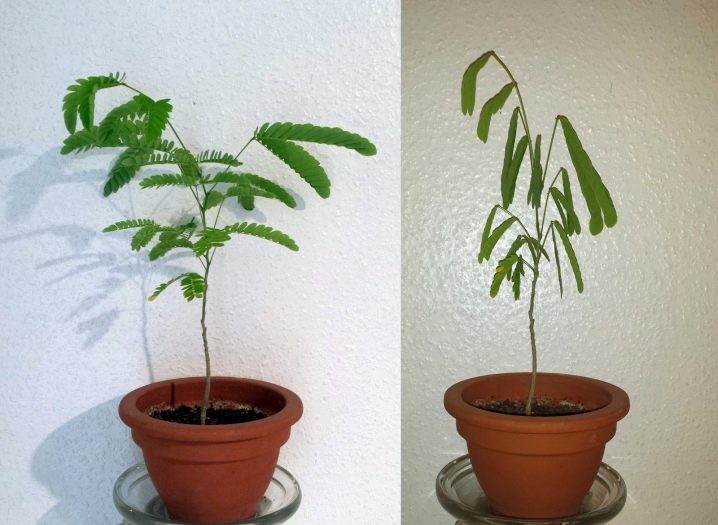
Of the pests, spider mites, mealybugs, and also scale insects are dangerous.... They parasitize by attaching themselves to the underside of the leaves. With a weak degree of damage, they can be exterminated by spraying with homemade soapy water.
If this method is not effective, you will have to process it with Aktellik or any similar pest control agent.
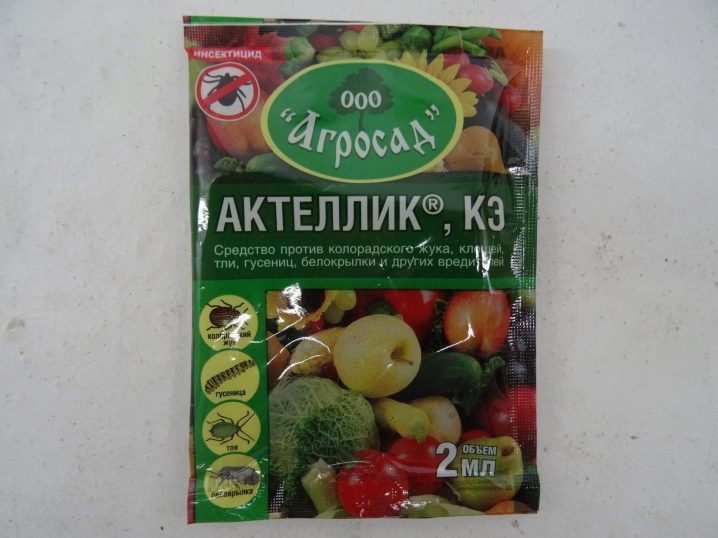



































































The comment was sent successfully.